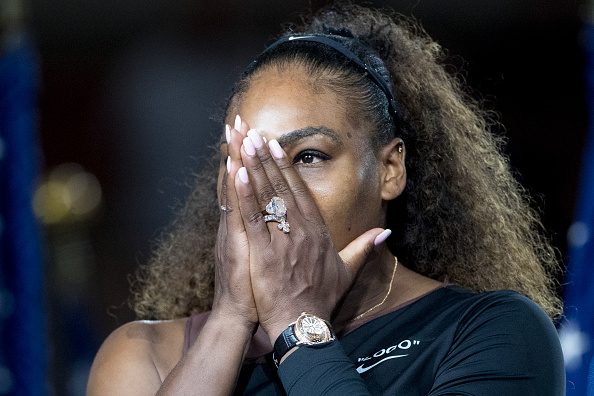THE TENNIS GODS MUST BE CRAZY
Bill Simons
“Our sport is a little better when there’s a touch of crazy.” – Chris McKendry
“This cannot happen,” said broadcaster Chris Fowler. But it did. There was no blood – no one got killed. But on September 8th we were baffled by a sporting debacle.
The most anticipated US Open final in memory – a delicious matchup between tennis’ prevailing queen and darling debutante Naomi Osaka – became a nightmare. Here was a soap opera disguised as a final. Fury and fire descended. A delightful dreamer was dazed, her glory muted. A celebrated champion imploded – a captive of emotion. Tennis has endured many dreadful moments – a stabbed player, near riots, howling arenas, stunning implosions, astounding chokes. The 2018 Open women’s final was a dystopian freefall. Its mighty footprint will long remain.
The script called for Serena – the superwoman who’d given birth and survived a brush with death only a year ago, and whose celebrity was soaring – to equal the record of 24 singles majors. Instead we witnessed ignominy and humiliation.
We ask sports to give us a definitive result and a dose of inspiration. Aside from Osaka’s courage and grit, the final gave us little of either. As I watched in Ashe Stadium, I was struck by the unsettling bookend quality of the match. Seventeen years ago I sat in a desert stadium as a crowd booed 19-year-old Serena for two hours. Now another, even bigger throng was howling – the roar nonstop, the stadium shaking. Again a young player endured cascading boos. Again Serena was surrounded by anger – but this time the masses were on her side. The fans were incensed, incessant and confused. I was scared – something bad could have happened.
The crowd’s mindset was clear: the ump should have swallowed his whistle. Instead Carlos Ramos had intervened at crunch time and derailed the moment. Now we’ll never know whether the greatest comeback player in women’s history could have somehow crafted a shock comeback against a foe who clearly had been in control.
Outside the arena, the conventional wisdom of the tennis world would be quite different and crystal clear: Serena had blown it. Her coach admitted he’d been coaching. She knew the rules but didn’t play by them. She should have been fully aware of the no-nonsense ump who was calling the match. As usual, Ramos was just going by the book. She’d played with fire and put her fate in his hands.
Many felt Serena had a sense of entitlement and was consumed by uncontrollable anger. At her worst, claimed Mary Carillo, Serena’s a bully. Okay, the warrior-mother once again had been triggered, but her righteous indignation knew no limits. Her sense of injustice was ill-placed. She wouldn’t let go. Veins bulging, finger pointing, her words were harsh – “You stole that game, you’re a thief!”
Yes, Serena’s a hero to so many, but again her volcanic emotions erupted. Her critics claimed that she was untrue to the sport and the essence of athletic competition – play by the rules, give it your all, be accountable and let the best person prevail.
*****
In my 38 years of covering this sport, I’ve probably been to 7,500 press conferences. But I’ve never had a more intense, mind-boggling moment than when Serena looked me in the eye as I asked her a carefully constructed question after the final.
“We can never really go back, Serena,” I began, “but if you could change one thing about what occurred, what would it be?” As she paused to reflect, I hoped she’d open up. She sure did.
Her voice wavering, fierce and emotional, she sighed and offered a provocative, teary answer that soon would be heard around the world: “I can’t sit here and say I wouldn’t say he’s a thief, because I thought he took a game from me. But I’ve seen other men call umpires several things. I’m here fighting for women’s rights and for women’s equality…For me to say ‘thief’ and for him to take a game, it made me feel like it was a sexist remark. He’s never taken a game from a man because he said ‘thief.’
“It blows my mind. But I’m going to continue to fight for women and to fight for us to have equal [rights]. Like [Alize] Cornet should be able to take off her shirt without getting a fine. This is outrageous. The fact that I have to go through this is just an example for the next person that has emotions, and wants to express themselves, and wants to be a strong woman. And they’re going to be allowed to do that because of today. Maybe it didn’t work out for me, but it’s going to work out for the next person.”
Her thunderous response hit me in the chest – I slumped in my seat. The press room was stunned. There was applause – yet savvy and presumably feminist women writers from New York and Germany grimaced – “Enough with sexism,” they grumbled.
The fallout from the most tumultuous, soul-searching tennis final in memory was off to a roaring start. The issues were obvious, complex and critical. On Twitter, I asked, “Has any other athlete ever provoked us, prodded us, frustrated us, taught us, entertained us, amazed us, baffled us and taken us to as many shores as the flawed and fabulous wonder woman #SerenaWilliams?”
Some chided me – “Give it a rest – enough already.” Serena fatigue hovers. Others asked, “Serena taught us what?” OMG – say what you will, this woman has taught us that you don’t have to come from a country club to prevail; that you can boycott an event where you were booed as a teen, that you can come back from wretched first-round losses, from a traumatic childbirth and from not one but two brushes with death, that you can win a Slam with a baby in your belly, and then give birth and become a two-time Slam finalist. Serena has taught us that sisterhood is powerful, that it’s fine to wear a daring body suit, to combat body shaming and oppose pay inequality for black women, and it’s fine to celebrate a big, black body. That it’s okay to marry a man of another race and call for racial justice in our legal system, that it’s okay to stand up for a quarterback who kneels and it’s critical to diffuse the hostility of an incensed crowd.
Only Serena could have calmed the throng at the Open’s dysfunctional award ceremony. She told them, “Let’s make this the best moment we can, and we’ll get through this…No more booing. Let’s give credit where credit is due.”
After I’d written my first think piece about the debacle on insidetennis.com, a Florida photographer called it “maybe the best tennis piece I’ve ever read.” Then, as I was getting all stoked up, a European journalist informed me that it was the worst piece I’d ever written. Welcome to Serenaville.
Perhaps no other athlete, maybe not even Muhammad Ali, has been more of a lightning rod than Ms. Williams. Two very different narratives soon emerged. Within tennis circles voices spoke loudly. Many insisted the rules are clear. Coaching is illegal. Man or woman, black or white, first round or final, rules are rules. But Serena’s backers said she didn’t see the signals. She never calls on her coach. There’s coaching in all sports and it should be allowed in tennis. And this was the first time Mourataglou had ever been called for coaching.
Okay, wrote Cindy Shmerler, “You can complain about the rules. But you can’t re-invent the rules in the middle of a match. What do we say to our loved ones when they are caught speeding and they argue that everyone else was going just as fast? Too bad, you got caught.”
Few defended Serena bashing her racket, except those who feel expressing intense emotion actually enlivens tennis. And while crushing a racket is a terrible example and a bad waste, it’s a harmless act – and it releases frustration. Boris Becker contends, “There are too many matches where you don’t see emotions, where you don’t see the ultimate battle…There are too many rules, players can’t do anything…It’s too proper, too politically correct. Tennis is unique – very raw. This is what we need to get back.”
But these days, such notions get little traction. More to the point was the issue of Ramos’ quick whistle. A wide range of officials and authoritative voices insisted he was just enforcing sensible rules, plus he’s known to be just the opposite of Mohamed Layhani, who came down to the court to comfort Nick Kyrgios. Ramos was being verbally accosted and he has a long history of snap interventions. Many were shocked when he cited Venus for supposedly receiving coaching in ’16. At the Olympics he issued a violation to Andy Murray for saying “stupid umpiring.” He gave Djokovic a violation for berating himself in Serbian and has been all over Nadal for time violations.
Some claim the rubber hit the road when Ramos called a third violation – a critical game penalty – for verbal abuse. A warning and even a point penalty are slaps on the wrist, but a game penalty, particularly deep into the final set of a Slam final, is a decisive, match-changing blow. Umps must be acutely aware of circumstances. Everyone knew Serena was steaming and pushing the limit. But Chris Evert noted that a game penalty in a Slam final has never happened in tennis before. Billie Jean King contended, “Serena was out of line – there’s no question. No one’s saying she was a good sport. The point is he aggravated the situation.”
In the moment, emotions sizzled. Serena’s pal Andy Roddick admitted he’d done far worse, and tweeted, “Worst refereeing I’ve ever seen…the worst!!!” And then he calmed down. Chris Fowler claimed, “Given the gravity of the moment, many, many people would say that restraint was called for.”
Many feel Ramos should have issued a warning: “Serena, this is it. I’m about to give you a violation and that will be a game. So stop – now.” Jon Wertheim noted, “There might be a rulebook, but officiating is also predicated on discretion and reading the room.”
Ramos’ call was the biggest in tennis history. Within the sport he drew widespread approval. Many celebrated the call – a courageous man made the right decision – even though it essentially ended the match. Osaka almost certainly would have prevailed, but at that moment the two were on serve and you never want to underestimate a Williams. We’ll never know if the game’s best comeback artist could somehow have stormed back. No major has never ended this way.
Afterward, an eminently appealing young champion was confused and in tears. The baffled, apologetic winner had all the appearances of a loser. She told the crowd, “I’m sorry it had to end like this.” One’s heart went out to the enchanting, fresh presence whom her coach described as “beautifully different.” He added, “Everyone on this planet could learn from her innocence.”
Serena is clearly not an innocent. No other active woman athlete has done so much or finds herself so enmeshed in controversy. To some she is a narcissist – fierce and unforgiving – while others say that, along with Michelle Obama and Beyoncé (who was on hand), she is one of three black avatars for African-American women. Her picture was just on the cover of Time and her image adorns bedrooms and classrooms across the land. Aspiring girls and overwhelmed mothers draw inspiration from her. Nerdy sociologists at conferences stand and chant her name. Mother, wife, social activist, online savant, celebrity and TV salesperson – her fans embrace her as a kind of wonder woman.
But in New York Serena could not control her rage. All women, especially black women, are taught to control themselves at all costs. But Serena was an athlete going for a big title, a big record and a $3.8 million check. Andre Agassi’s guru, Gil Reyes, told us, “Just think about all the things that are so special about sports – the human spirit, the human will, having a genuine love and respect for each other – and the biggest respect you can give an athlete is to give it all you have against them.” That didn’t exactly happen here.
Within tennis there is near unanimity – Serena’s behavior was deplorable. Beyond the game there is much debate. What was the impact of her Jehovah’s Witness religion? What was the effect of her struggles with postpartum depression? Of late she’d often been stuck in a funk and had wrestled with maternal guilt – she’d missed her daughter’s first steps.
And what of the roles of racism and sexism? “You are attacking my character,” Serena told Ramos. “Say you’re sorry. You owe me an apology…You’re a thief!… This has happened to me too many times. Do you know how many men said a lot worse?…Because I’m a woman you’re going to take this away from me?…Every single year it’s [something].”
“No way,” was a common response. “You’re the one that owes an apology. Gender and race had nothing to do with it.” A vile Australian cartoon portraying Serena as subhuman was dismissed as an outlier. Others wondered why Serena has been sanctioned and condemned so much more often than others. She’s been called old, fat, and masculine, and there was the incident with the Indian Wells crowd in ‘01. Then in ’03 Serena accused Justine Henin of “lying and fabricating” about a pivotal serve at the French Open. Eight years later the Belgian offered a soft apology. At the ’04 Open, Serena suffered four bad calls when playing Jennifer Capriati, an injustice that drew a USTA apology and quickly led to electronic scoring. Serena said she was bitter and felt “robbed” and “cheated.”
At crunch time in the ’09 Open semis against Kim Clijsters, Serena was somewhat inexplicably called for a foot fault. McEnroe and others thought it was a wretched call – and Serena let loose with one of the most threatening rants in tennis history. She told the linesperson she was going to shove a ball “down your f—–g throat” and was fined $100,000. Then, at a key moment against Sam Stosur in the ’11 Open final, she was penalized for yelling “C’mon!” just after hitting what looked to be an irretrievable winner. The call cost her a game and Serena told the ump she was “unattractive inside.”
There has never been a narrative like this in tennis history. Not only have there been so many bad or borderline calls against a single player, but they virtually all came at critical junctures deep into Slams. Each time Serena raged. Twenty-two percent of her 18 US Opens have ended in chaos.
Speaking of numbers, a stats skirmish broke out when the New York Times’ Christopher Clarey published a slew of figures that indicated that men were penalized more often than women. But stats whiz Nate Silver said the data “doesn’t tell us anything about whether genders are punished at greater rates.” The issue, according to the Tennis Channel’s Brett Haber, is not the quantity of penalties, but rather “the differing thresholds for penalties between the genders.”
All the while, a study showed that in 3,500 recent matches only one male player, Grigor Dimitrov, had been issued a game penalty. And that was when he smashed his racket three times in a row.
The stats squabble had little impact on Serena’s backers. Writer Gillian White claimed, “The support for Williams…[comes] in part because some have an enduring memory of how difficult it is for women of color to make it in expensive, mostly white sports.”
Serena’s supporters noted that male rage has long been a part of tennis and has been used to sell the sport, plus countless other products. During this year’s Open final, Jimmy Connors’ temper was celebrated. His finger-wagging, “You are an abortion!” outbursts were featured on the big screen, and his hugely popular, angst-filled ’91 rants made the Open a must-see event and gained the USTA millions.
Even more than Connors, John McEnroe built a career based on his temper. Goodness, Federer told the ump at the ‘09 Open final, “I don’t give a s–t what he [del Potro] says…Don’t f–king tell me the rules.” And he said, “F–k off” at the ‘13 ATP Finals.
Certainly, Serena was in a rage and way into Ramos’ grill. She’s an intimidating force. Still, writer Sally Jenkins stirred controversy when she claimed Ramos “couldn’t take it. He wasn’t going to let a woman talk to him that way, pointing a finger and using a tone of aggression.” Billie Jean tweeted, “When a woman is emotional, she’s hysterical and she’s penalized for it. When a man does the same, he’s ‘outspoken’ and there are no repercussions.”
Martina Navratilova differed, contending that it wasn’t good “to apply a standard of ‘If men can get away with it, women should be able to, too.’…We cannot measure ourselves by what we think we should also be able to get away with…This is the sort of behavior that no one should be engaging in…It is also on players to conduct themselves with respect.”
Others say, “Hold on. Well-behaved women seldom make history,” and they called on feminist perspectives. Rebecca Traister suggested, “The ask of women, and most especially, of nonwhite women, since the beginning of time [is] take the diminution and injustice and don’t get mad; if you get mad, you will get punished, and be expected to fix it and to make sure everyone is comfortable again.” Salamishah Tillet wrote that Serena “was punished for showing emotion, for defiance, for being the player she has always been – driven, passionate, proud and fully human. She liberated herself of constraint…fought back and reminded the world of her greatness.”
But Shmerler asserted, “For Serena to suggest that her treatment was gender-related is just plain wrong.” “Making Serena’s behavior into a sexist issue,” contended commentator Christopher Bowers, “undermines the fight for genuine equality. We admire Serena for who she is and her body of work, but…[we shouldn’t give a] free pass for the rich and famous to intimidate those lesser-paid mortals charged with administering rules that are supposed to apply to everyone.”
One longtime tennis observer said, “I hope Serena embraces her humanity. She may have lost that night at the Open, but she’s still winning the journey to become her full self, and that’s what really matters.”
In an era when the middle doesn’t seem to be holding, a tennis match reflected a world that at times feels like it’s coming apart at the seams. Ultimately, we know that Serena is a force like no other. More than any athlete, she provokes and gets us thinking. Some say that on that fateful night we endured a mean-spirited bully becoming unhinged. Others believe they saw the righteous rage of a bold warrior. Can we possibly hold these two vastly different narratives within ourselves? And, if we can, is that somehow a mark of progress?
And in the end, maybe ESPN’s Chris McKendry got it right when she said, “Our sport is a little better when there’s a touch of crazy.”



















